Psychology Assignment: Application of Operant Conditioning on Behavior
VerifiedAdded on 2021/04/17
|12
|2915
|23
Homework Assignment
AI Summary
This psychology assignment delves into the principles of operant conditioning, a concept developed by B.F. Skinner, focusing on how behavior can be modified through positive and negative reinforcements. The assignment examines how the student applied these principles to change their own behavior, specifically their engagement in cardio exercises. The student used listening to audiobooks as a positive reinforcement, observing how their cardio time increased with their interest in the audiobooks. The assignment includes baseline data, program implementation, and a critical evaluation of the program's effectiveness. Factors such as class schedules and the availability of engaging audiobooks were found to influence the success of the behavior modification. The student concludes that operant conditioning can be a successful method for improving exercise habits, emphasizing the importance of maintaining interest and managing time constraints.
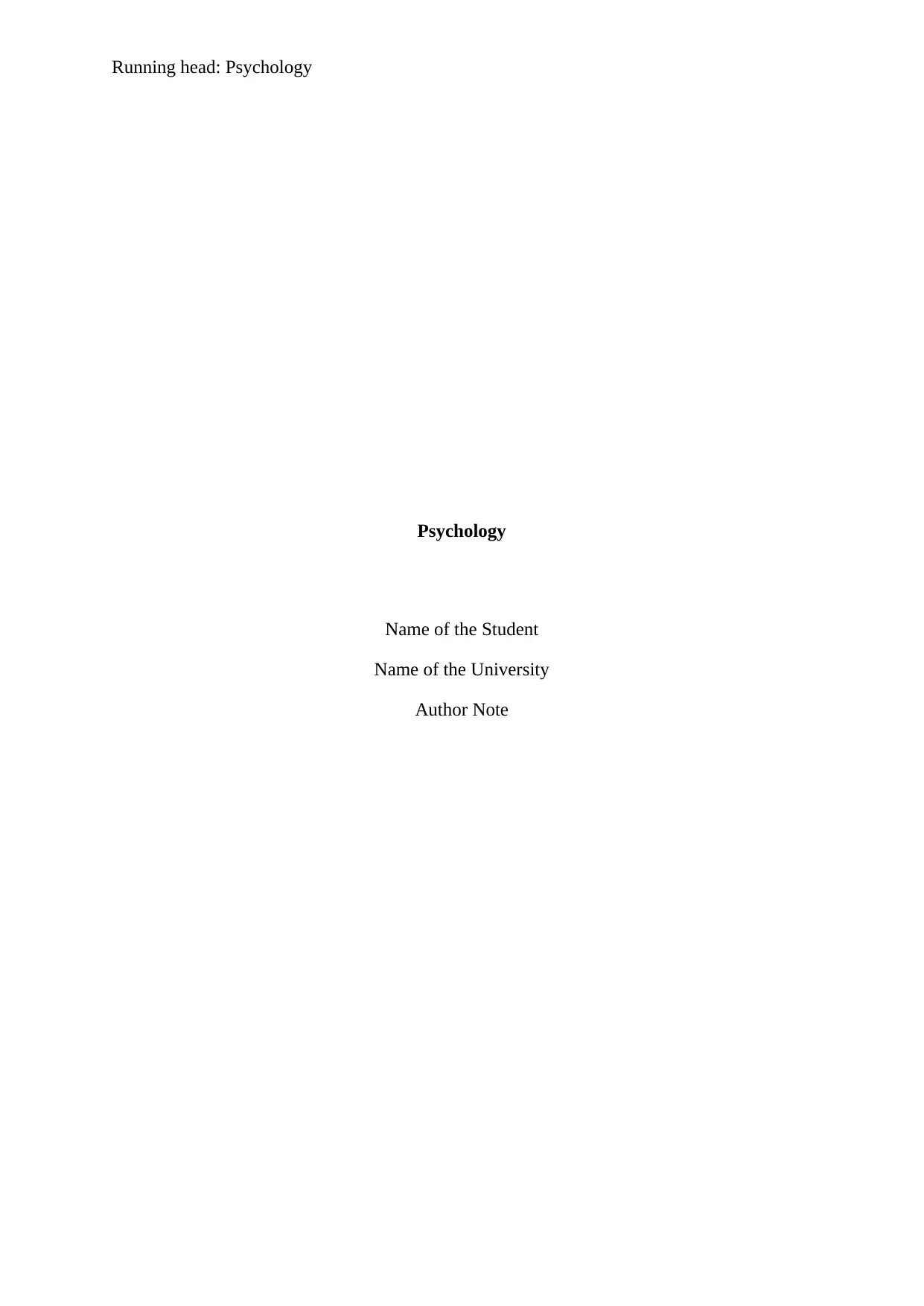
Running head: Psychology
Psychology
Name of the Student
Name of the University
Author Note
Psychology
Name of the Student
Name of the University
Author Note
Paraphrase This Document
Need a fresh take? Get an instant paraphrase of this document with our AI Paraphraser
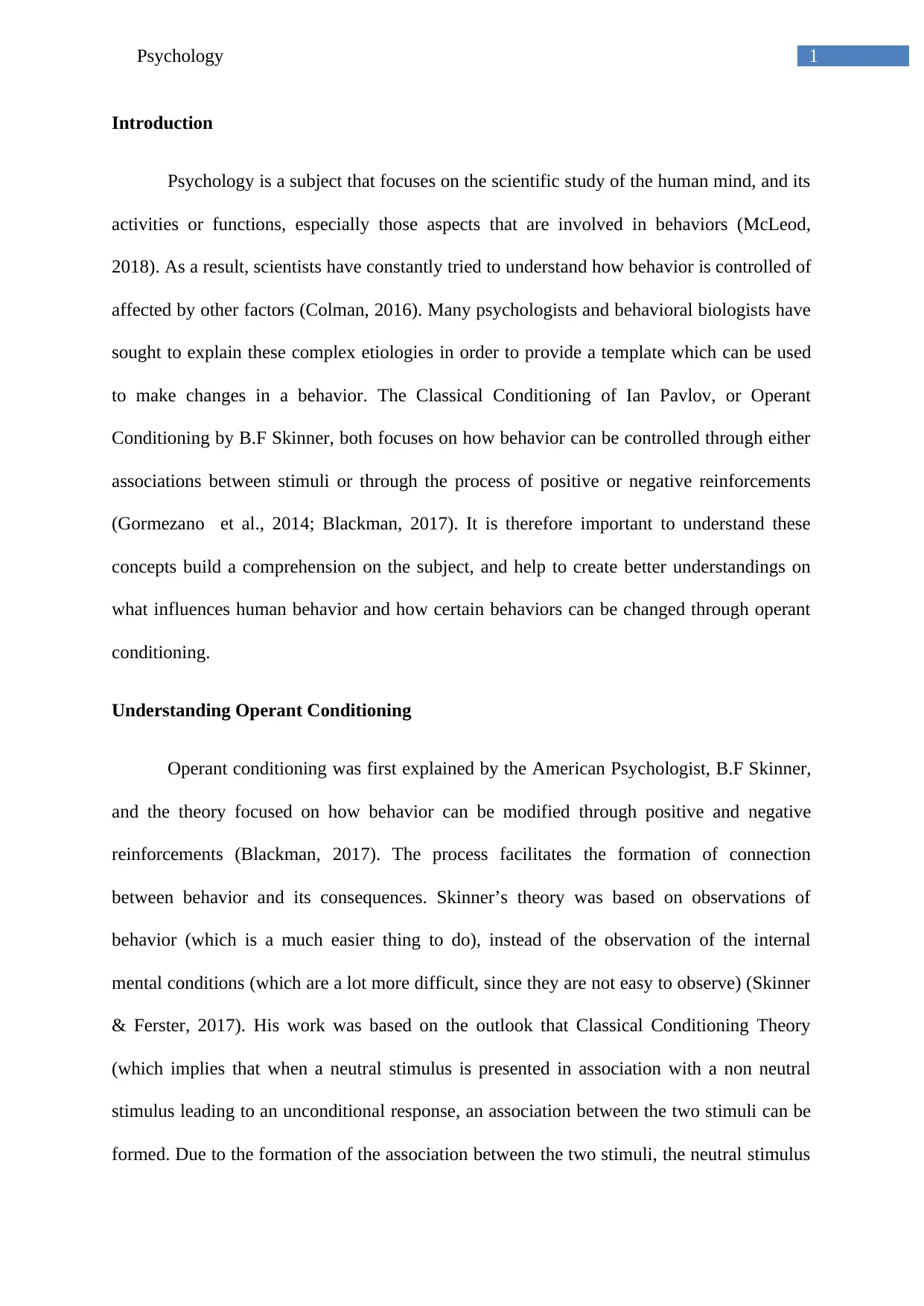
1Psychology
Introduction
Psychology is a subject that focuses on the scientific study of the human mind, and its
activities or functions, especially those aspects that are involved in behaviors (McLeod,
2018). As a result, scientists have constantly tried to understand how behavior is controlled of
affected by other factors (Colman, 2016). Many psychologists and behavioral biologists have
sought to explain these complex etiologies in order to provide a template which can be used
to make changes in a behavior. The Classical Conditioning of Ian Pavlov, or Operant
Conditioning by B.F Skinner, both focuses on how behavior can be controlled through either
associations between stimuli or through the process of positive or negative reinforcements
(Gormezano et al., 2014; Blackman, 2017). It is therefore important to understand these
concepts build a comprehension on the subject, and help to create better understandings on
what influences human behavior and how certain behaviors can be changed through operant
conditioning.
Understanding Operant Conditioning
Operant conditioning was first explained by the American Psychologist, B.F Skinner,
and the theory focused on how behavior can be modified through positive and negative
reinforcements (Blackman, 2017). The process facilitates the formation of connection
between behavior and its consequences. Skinner’s theory was based on observations of
behavior (which is a much easier thing to do), instead of the observation of the internal
mental conditions (which are a lot more difficult, since they are not easy to observe) (Skinner
& Ferster, 2017). His work was based on the outlook that Classical Conditioning Theory
(which implies that when a neutral stimulus is presented in association with a non neutral
stimulus leading to an unconditional response, an association between the two stimuli can be
formed. Due to the formation of the association between the two stimuli, the neutral stimulus
Introduction
Psychology is a subject that focuses on the scientific study of the human mind, and its
activities or functions, especially those aspects that are involved in behaviors (McLeod,
2018). As a result, scientists have constantly tried to understand how behavior is controlled of
affected by other factors (Colman, 2016). Many psychologists and behavioral biologists have
sought to explain these complex etiologies in order to provide a template which can be used
to make changes in a behavior. The Classical Conditioning of Ian Pavlov, or Operant
Conditioning by B.F Skinner, both focuses on how behavior can be controlled through either
associations between stimuli or through the process of positive or negative reinforcements
(Gormezano et al., 2014; Blackman, 2017). It is therefore important to understand these
concepts build a comprehension on the subject, and help to create better understandings on
what influences human behavior and how certain behaviors can be changed through operant
conditioning.
Understanding Operant Conditioning
Operant conditioning was first explained by the American Psychologist, B.F Skinner,
and the theory focused on how behavior can be modified through positive and negative
reinforcements (Blackman, 2017). The process facilitates the formation of connection
between behavior and its consequences. Skinner’s theory was based on observations of
behavior (which is a much easier thing to do), instead of the observation of the internal
mental conditions (which are a lot more difficult, since they are not easy to observe) (Skinner
& Ferster, 2017). His work was based on the outlook that Classical Conditioning Theory
(which implies that when a neutral stimulus is presented in association with a non neutral
stimulus leading to an unconditional response, an association between the two stimuli can be
formed. Due to the formation of the association between the two stimuli, the neutral stimulus
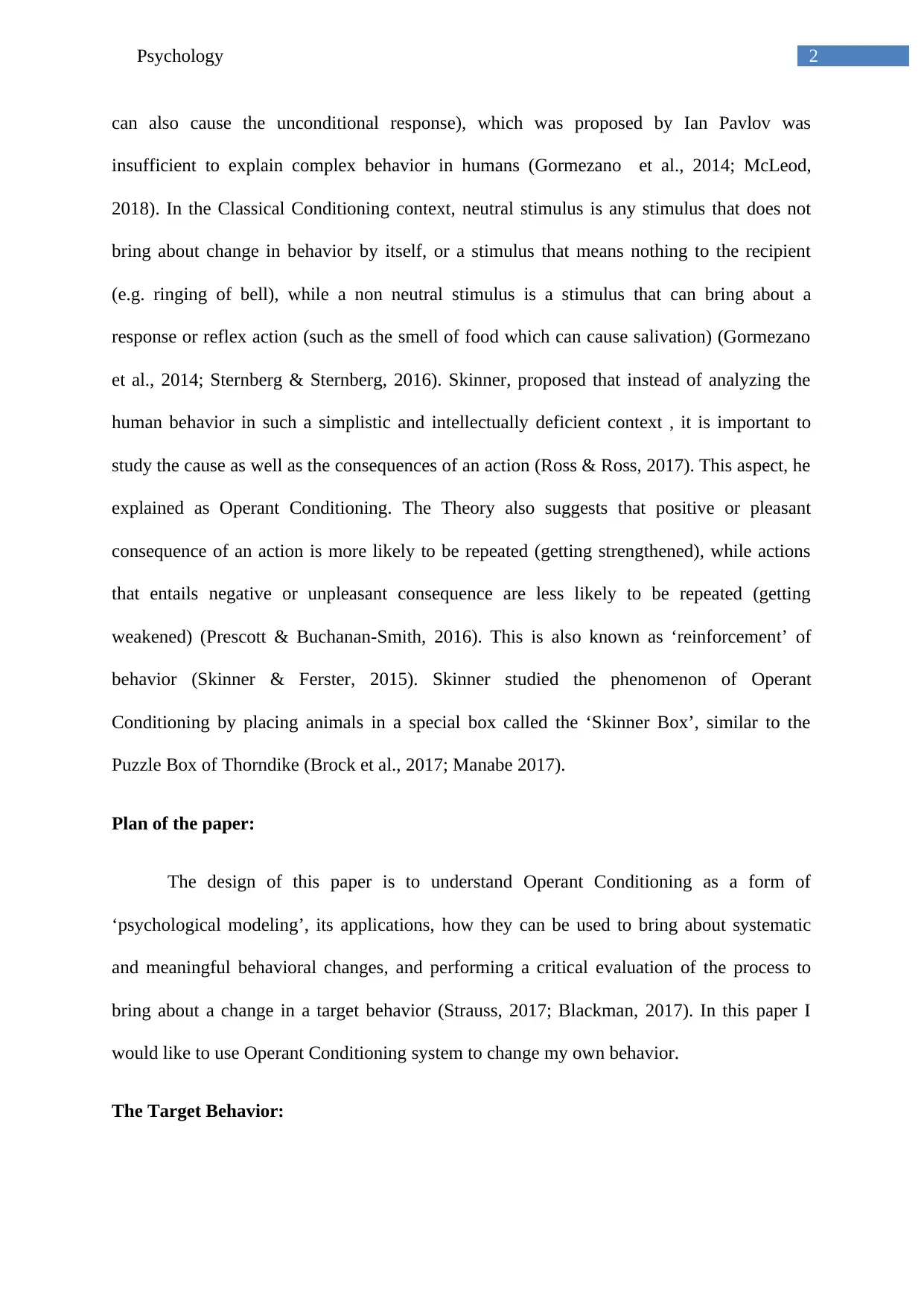
2Psychology
can also cause the unconditional response), which was proposed by Ian Pavlov was
insufficient to explain complex behavior in humans (Gormezano et al., 2014; McLeod,
2018). In the Classical Conditioning context, neutral stimulus is any stimulus that does not
bring about change in behavior by itself, or a stimulus that means nothing to the recipient
(e.g. ringing of bell), while a non neutral stimulus is a stimulus that can bring about a
response or reflex action (such as the smell of food which can cause salivation) (Gormezano
et al., 2014; Sternberg & Sternberg, 2016). Skinner, proposed that instead of analyzing the
human behavior in such a simplistic and intellectually deficient context , it is important to
study the cause as well as the consequences of an action (Ross & Ross, 2017). This aspect, he
explained as Operant Conditioning. The Theory also suggests that positive or pleasant
consequence of an action is more likely to be repeated (getting strengthened), while actions
that entails negative or unpleasant consequence are less likely to be repeated (getting
weakened) (Prescott & Buchanan-Smith, 2016). This is also known as ‘reinforcement’ of
behavior (Skinner & Ferster, 2015). Skinner studied the phenomenon of Operant
Conditioning by placing animals in a special box called the ‘Skinner Box’, similar to the
Puzzle Box of Thorndike (Brock et al., 2017; Manabe 2017).
Plan of the paper:
The design of this paper is to understand Operant Conditioning as a form of
‘psychological modeling’, its applications, how they can be used to bring about systematic
and meaningful behavioral changes, and performing a critical evaluation of the process to
bring about a change in a target behavior (Strauss, 2017; Blackman, 2017). In this paper I
would like to use Operant Conditioning system to change my own behavior.
The Target Behavior:
can also cause the unconditional response), which was proposed by Ian Pavlov was
insufficient to explain complex behavior in humans (Gormezano et al., 2014; McLeod,
2018). In the Classical Conditioning context, neutral stimulus is any stimulus that does not
bring about change in behavior by itself, or a stimulus that means nothing to the recipient
(e.g. ringing of bell), while a non neutral stimulus is a stimulus that can bring about a
response or reflex action (such as the smell of food which can cause salivation) (Gormezano
et al., 2014; Sternberg & Sternberg, 2016). Skinner, proposed that instead of analyzing the
human behavior in such a simplistic and intellectually deficient context , it is important to
study the cause as well as the consequences of an action (Ross & Ross, 2017). This aspect, he
explained as Operant Conditioning. The Theory also suggests that positive or pleasant
consequence of an action is more likely to be repeated (getting strengthened), while actions
that entails negative or unpleasant consequence are less likely to be repeated (getting
weakened) (Prescott & Buchanan-Smith, 2016). This is also known as ‘reinforcement’ of
behavior (Skinner & Ferster, 2015). Skinner studied the phenomenon of Operant
Conditioning by placing animals in a special box called the ‘Skinner Box’, similar to the
Puzzle Box of Thorndike (Brock et al., 2017; Manabe 2017).
Plan of the paper:
The design of this paper is to understand Operant Conditioning as a form of
‘psychological modeling’, its applications, how they can be used to bring about systematic
and meaningful behavioral changes, and performing a critical evaluation of the process to
bring about a change in a target behavior (Strauss, 2017; Blackman, 2017). In this paper I
would like to use Operant Conditioning system to change my own behavior.
The Target Behavior:
⊘ This is a preview!⊘
Do you want full access?
Subscribe today to unlock all pages.

Trusted by 1+ million students worldwide
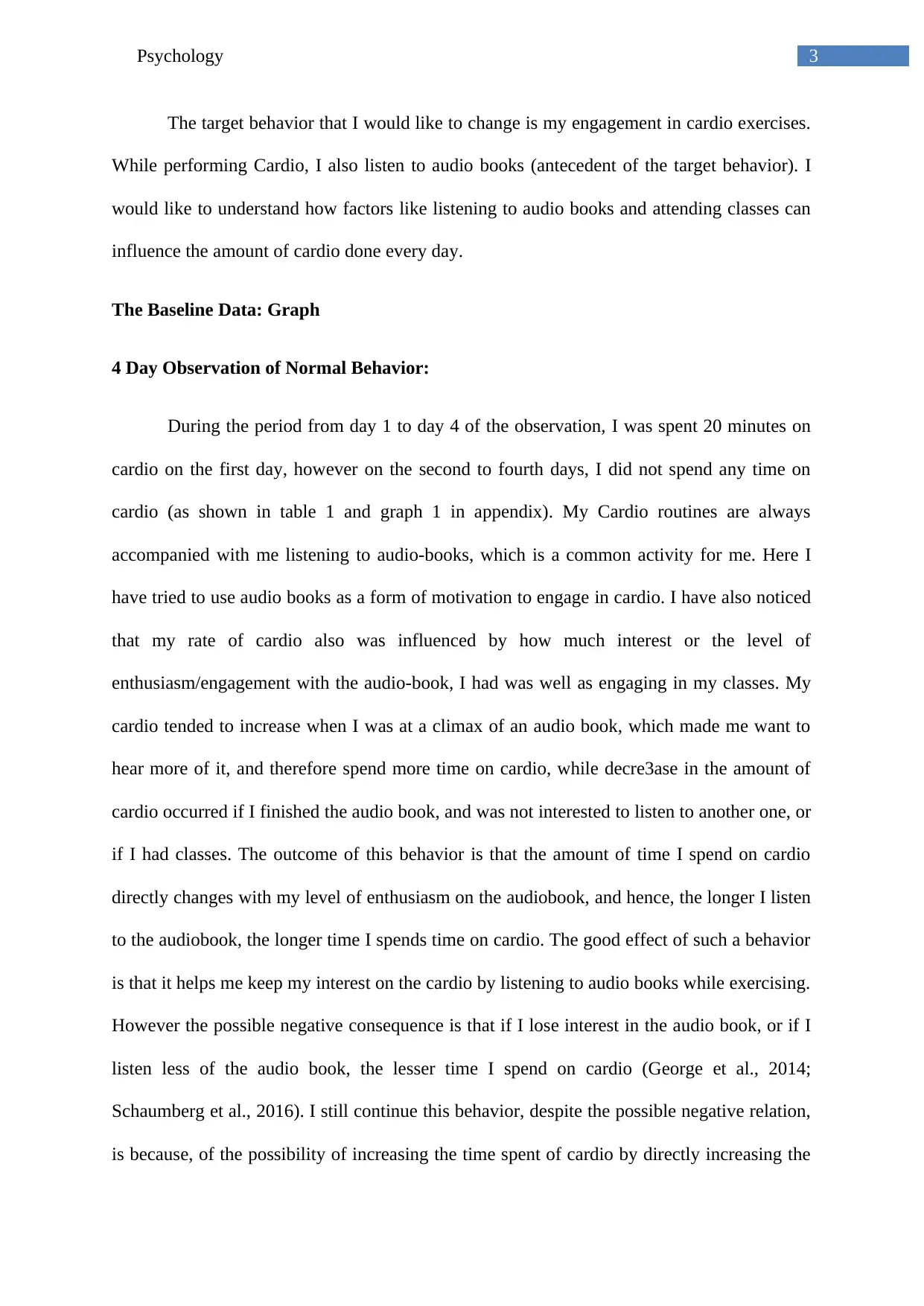
3Psychology
The target behavior that I would like to change is my engagement in cardio exercises.
While performing Cardio, I also listen to audio books (antecedent of the target behavior). I
would like to understand how factors like listening to audio books and attending classes can
influence the amount of cardio done every day.
The Baseline Data: Graph
4 Day Observation of Normal Behavior:
During the period from day 1 to day 4 of the observation, I was spent 20 minutes on
cardio on the first day, however on the second to fourth days, I did not spend any time on
cardio (as shown in table 1 and graph 1 in appendix). My Cardio routines are always
accompanied with me listening to audio-books, which is a common activity for me. Here I
have tried to use audio books as a form of motivation to engage in cardio. I have also noticed
that my rate of cardio also was influenced by how much interest or the level of
enthusiasm/engagement with the audio-book, I had was well as engaging in my classes. My
cardio tended to increase when I was at a climax of an audio book, which made me want to
hear more of it, and therefore spend more time on cardio, while decre3ase in the amount of
cardio occurred if I finished the audio book, and was not interested to listen to another one, or
if I had classes. The outcome of this behavior is that the amount of time I spend on cardio
directly changes with my level of enthusiasm on the audiobook, and hence, the longer I listen
to the audiobook, the longer time I spends time on cardio. The good effect of such a behavior
is that it helps me keep my interest on the cardio by listening to audio books while exercising.
However the possible negative consequence is that if I lose interest in the audio book, or if I
listen less of the audio book, the lesser time I spend on cardio (George et al., 2014;
Schaumberg et al., 2016). I still continue this behavior, despite the possible negative relation,
is because, of the possibility of increasing the time spent of cardio by directly increasing the
The target behavior that I would like to change is my engagement in cardio exercises.
While performing Cardio, I also listen to audio books (antecedent of the target behavior). I
would like to understand how factors like listening to audio books and attending classes can
influence the amount of cardio done every day.
The Baseline Data: Graph
4 Day Observation of Normal Behavior:
During the period from day 1 to day 4 of the observation, I was spent 20 minutes on
cardio on the first day, however on the second to fourth days, I did not spend any time on
cardio (as shown in table 1 and graph 1 in appendix). My Cardio routines are always
accompanied with me listening to audio-books, which is a common activity for me. Here I
have tried to use audio books as a form of motivation to engage in cardio. I have also noticed
that my rate of cardio also was influenced by how much interest or the level of
enthusiasm/engagement with the audio-book, I had was well as engaging in my classes. My
cardio tended to increase when I was at a climax of an audio book, which made me want to
hear more of it, and therefore spend more time on cardio, while decre3ase in the amount of
cardio occurred if I finished the audio book, and was not interested to listen to another one, or
if I had classes. The outcome of this behavior is that the amount of time I spend on cardio
directly changes with my level of enthusiasm on the audiobook, and hence, the longer I listen
to the audiobook, the longer time I spends time on cardio. The good effect of such a behavior
is that it helps me keep my interest on the cardio by listening to audio books while exercising.
However the possible negative consequence is that if I lose interest in the audio book, or if I
listen less of the audio book, the lesser time I spend on cardio (George et al., 2014;
Schaumberg et al., 2016). I still continue this behavior, despite the possible negative relation,
is because, of the possibility of increasing the time spent of cardio by directly increasing the
Paraphrase This Document
Need a fresh take? Get an instant paraphrase of this document with our AI Paraphraser
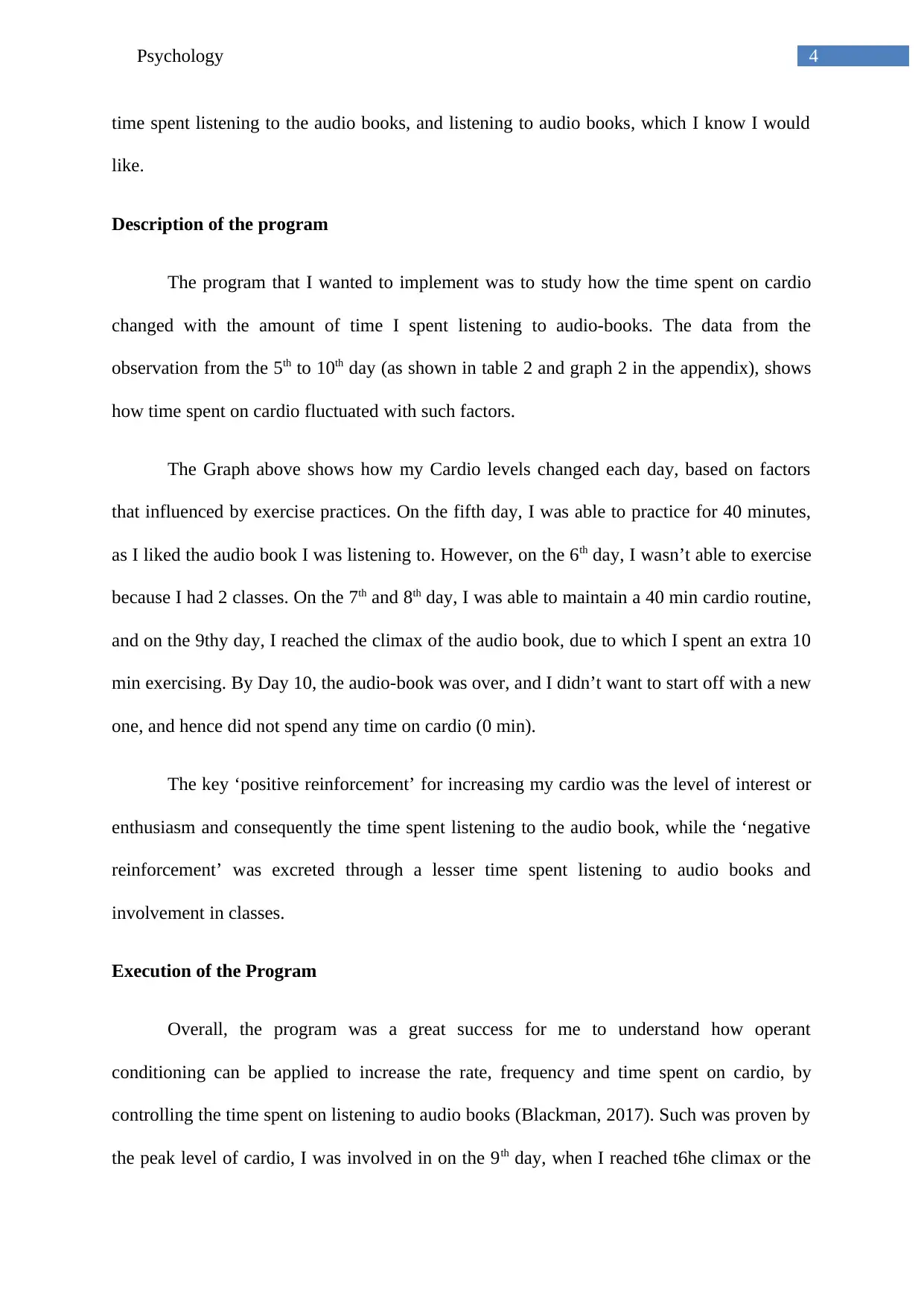
4Psychology
time spent listening to the audio books, and listening to audio books, which I know I would
like.
Description of the program
The program that I wanted to implement was to study how the time spent on cardio
changed with the amount of time I spent listening to audio-books. The data from the
observation from the 5th to 10th day (as shown in table 2 and graph 2 in the appendix), shows
how time spent on cardio fluctuated with such factors.
The Graph above shows how my Cardio levels changed each day, based on factors
that influenced by exercise practices. On the fifth day, I was able to practice for 40 minutes,
as I liked the audio book I was listening to. However, on the 6th day, I wasn’t able to exercise
because I had 2 classes. On the 7th and 8th day, I was able to maintain a 40 min cardio routine,
and on the 9thy day, I reached the climax of the audio book, due to which I spent an extra 10
min exercising. By Day 10, the audio-book was over, and I didn’t want to start off with a new
one, and hence did not spend any time on cardio (0 min).
The key ‘positive reinforcement’ for increasing my cardio was the level of interest or
enthusiasm and consequently the time spent listening to the audio book, while the ‘negative
reinforcement’ was excreted through a lesser time spent listening to audio books and
involvement in classes.
Execution of the Program
Overall, the program was a great success for me to understand how operant
conditioning can be applied to increase the rate, frequency and time spent on cardio, by
controlling the time spent on listening to audio books (Blackman, 2017). Such was proven by
the peak level of cardio, I was involved in on the 9th day, when I reached t6he climax or the
time spent listening to the audio books, and listening to audio books, which I know I would
like.
Description of the program
The program that I wanted to implement was to study how the time spent on cardio
changed with the amount of time I spent listening to audio-books. The data from the
observation from the 5th to 10th day (as shown in table 2 and graph 2 in the appendix), shows
how time spent on cardio fluctuated with such factors.
The Graph above shows how my Cardio levels changed each day, based on factors
that influenced by exercise practices. On the fifth day, I was able to practice for 40 minutes,
as I liked the audio book I was listening to. However, on the 6th day, I wasn’t able to exercise
because I had 2 classes. On the 7th and 8th day, I was able to maintain a 40 min cardio routine,
and on the 9thy day, I reached the climax of the audio book, due to which I spent an extra 10
min exercising. By Day 10, the audio-book was over, and I didn’t want to start off with a new
one, and hence did not spend any time on cardio (0 min).
The key ‘positive reinforcement’ for increasing my cardio was the level of interest or
enthusiasm and consequently the time spent listening to the audio book, while the ‘negative
reinforcement’ was excreted through a lesser time spent listening to audio books and
involvement in classes.
Execution of the Program
Overall, the program was a great success for me to understand how operant
conditioning can be applied to increase the rate, frequency and time spent on cardio, by
controlling the time spent on listening to audio books (Blackman, 2017). Such was proven by
the peak level of cardio, I was involved in on the 9th day, when I reached t6he climax or the
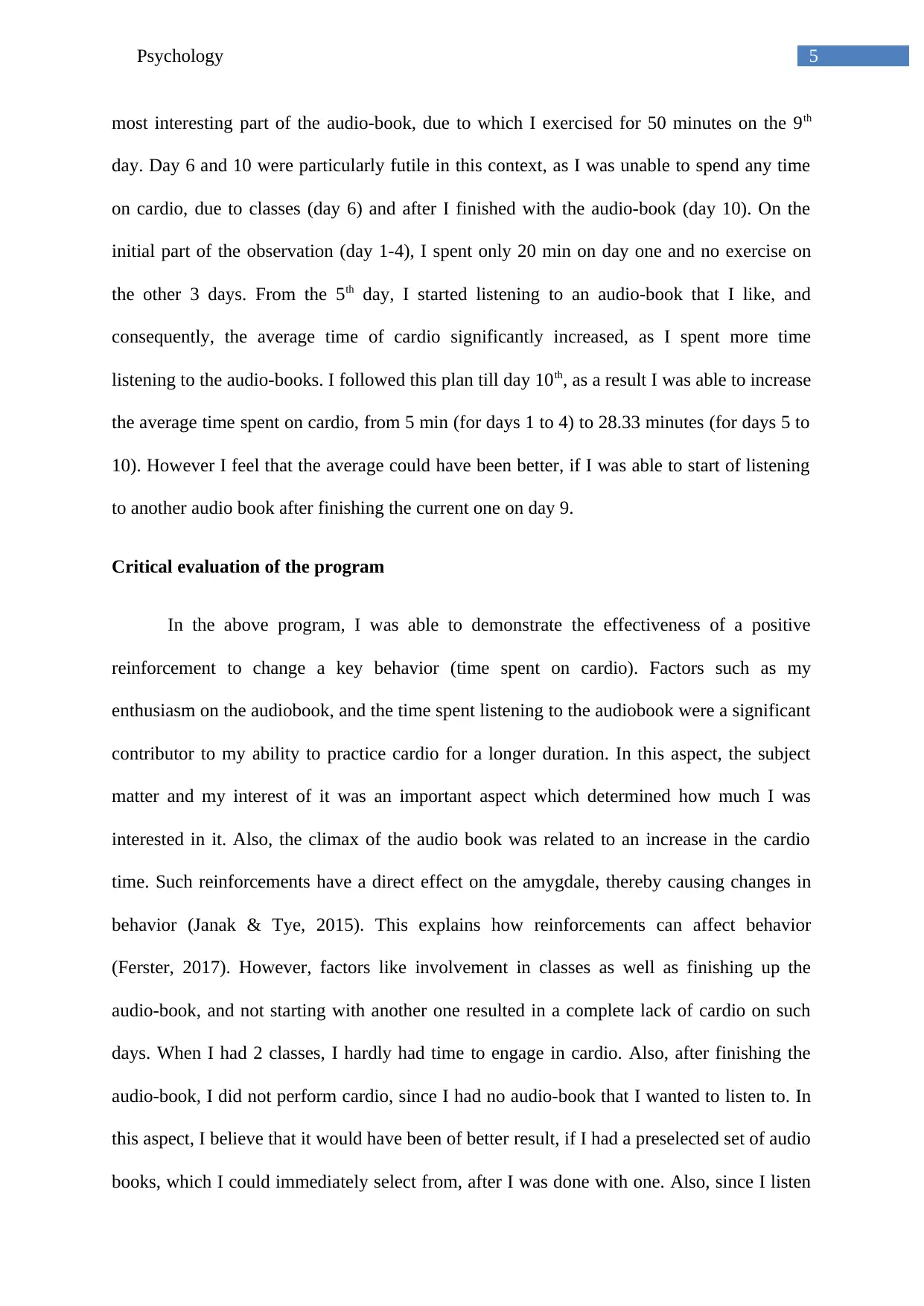
5Psychology
most interesting part of the audio-book, due to which I exercised for 50 minutes on the 9th
day. Day 6 and 10 were particularly futile in this context, as I was unable to spend any time
on cardio, due to classes (day 6) and after I finished with the audio-book (day 10). On the
initial part of the observation (day 1-4), I spent only 20 min on day one and no exercise on
the other 3 days. From the 5th day, I started listening to an audio-book that I like, and
consequently, the average time of cardio significantly increased, as I spent more time
listening to the audio-books. I followed this plan till day 10th, as a result I was able to increase
the average time spent on cardio, from 5 min (for days 1 to 4) to 28.33 minutes (for days 5 to
10). However I feel that the average could have been better, if I was able to start of listening
to another audio book after finishing the current one on day 9.
Critical evaluation of the program
In the above program, I was able to demonstrate the effectiveness of a positive
reinforcement to change a key behavior (time spent on cardio). Factors such as my
enthusiasm on the audiobook, and the time spent listening to the audiobook were a significant
contributor to my ability to practice cardio for a longer duration. In this aspect, the subject
matter and my interest of it was an important aspect which determined how much I was
interested in it. Also, the climax of the audio book was related to an increase in the cardio
time. Such reinforcements have a direct effect on the amygdale, thereby causing changes in
behavior (Janak & Tye, 2015). This explains how reinforcements can affect behavior
(Ferster, 2017). However, factors like involvement in classes as well as finishing up the
audio-book, and not starting with another one resulted in a complete lack of cardio on such
days. When I had 2 classes, I hardly had time to engage in cardio. Also, after finishing the
audio-book, I did not perform cardio, since I had no audio-book that I wanted to listen to. In
this aspect, I believe that it would have been of better result, if I had a preselected set of audio
books, which I could immediately select from, after I was done with one. Also, since I listen
most interesting part of the audio-book, due to which I exercised for 50 minutes on the 9th
day. Day 6 and 10 were particularly futile in this context, as I was unable to spend any time
on cardio, due to classes (day 6) and after I finished with the audio-book (day 10). On the
initial part of the observation (day 1-4), I spent only 20 min on day one and no exercise on
the other 3 days. From the 5th day, I started listening to an audio-book that I like, and
consequently, the average time of cardio significantly increased, as I spent more time
listening to the audio-books. I followed this plan till day 10th, as a result I was able to increase
the average time spent on cardio, from 5 min (for days 1 to 4) to 28.33 minutes (for days 5 to
10). However I feel that the average could have been better, if I was able to start of listening
to another audio book after finishing the current one on day 9.
Critical evaluation of the program
In the above program, I was able to demonstrate the effectiveness of a positive
reinforcement to change a key behavior (time spent on cardio). Factors such as my
enthusiasm on the audiobook, and the time spent listening to the audiobook were a significant
contributor to my ability to practice cardio for a longer duration. In this aspect, the subject
matter and my interest of it was an important aspect which determined how much I was
interested in it. Also, the climax of the audio book was related to an increase in the cardio
time. Such reinforcements have a direct effect on the amygdale, thereby causing changes in
behavior (Janak & Tye, 2015). This explains how reinforcements can affect behavior
(Ferster, 2017). However, factors like involvement in classes as well as finishing up the
audio-book, and not starting with another one resulted in a complete lack of cardio on such
days. When I had 2 classes, I hardly had time to engage in cardio. Also, after finishing the
audio-book, I did not perform cardio, since I had no audio-book that I wanted to listen to. In
this aspect, I believe that it would have been of better result, if I had a preselected set of audio
books, which I could immediately select from, after I was done with one. Also, since I listen
⊘ This is a preview!⊘
Do you want full access?
Subscribe today to unlock all pages.

Trusted by 1+ million students worldwide
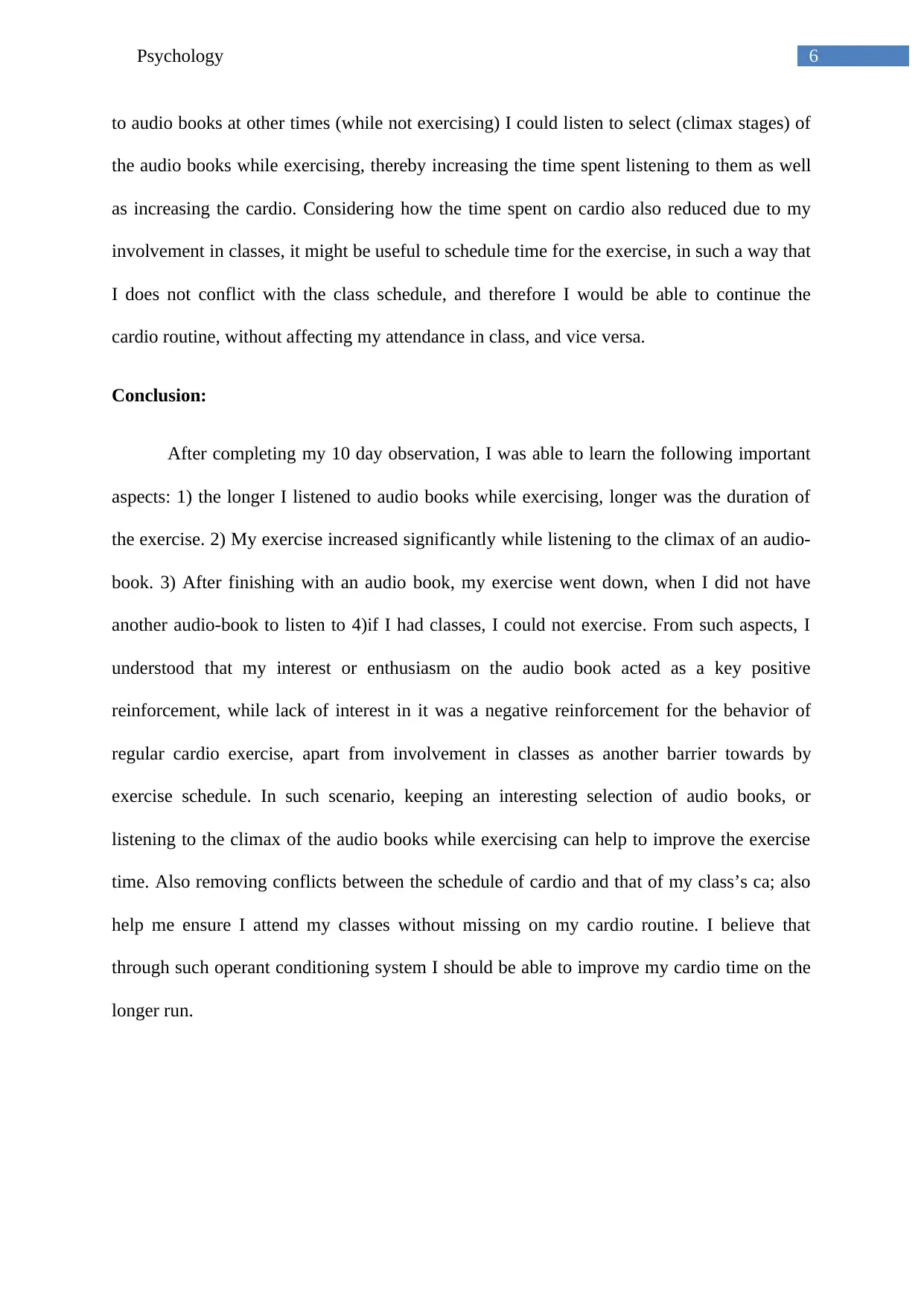
6Psychology
to audio books at other times (while not exercising) I could listen to select (climax stages) of
the audio books while exercising, thereby increasing the time spent listening to them as well
as increasing the cardio. Considering how the time spent on cardio also reduced due to my
involvement in classes, it might be useful to schedule time for the exercise, in such a way that
I does not conflict with the class schedule, and therefore I would be able to continue the
cardio routine, without affecting my attendance in class, and vice versa.
Conclusion:
After completing my 10 day observation, I was able to learn the following important
aspects: 1) the longer I listened to audio books while exercising, longer was the duration of
the exercise. 2) My exercise increased significantly while listening to the climax of an audio-
book. 3) After finishing with an audio book, my exercise went down, when I did not have
another audio-book to listen to 4)if I had classes, I could not exercise. From such aspects, I
understood that my interest or enthusiasm on the audio book acted as a key positive
reinforcement, while lack of interest in it was a negative reinforcement for the behavior of
regular cardio exercise, apart from involvement in classes as another barrier towards by
exercise schedule. In such scenario, keeping an interesting selection of audio books, or
listening to the climax of the audio books while exercising can help to improve the exercise
time. Also removing conflicts between the schedule of cardio and that of my class’s ca; also
help me ensure I attend my classes without missing on my cardio routine. I believe that
through such operant conditioning system I should be able to improve my cardio time on the
longer run.
to audio books at other times (while not exercising) I could listen to select (climax stages) of
the audio books while exercising, thereby increasing the time spent listening to them as well
as increasing the cardio. Considering how the time spent on cardio also reduced due to my
involvement in classes, it might be useful to schedule time for the exercise, in such a way that
I does not conflict with the class schedule, and therefore I would be able to continue the
cardio routine, without affecting my attendance in class, and vice versa.
Conclusion:
After completing my 10 day observation, I was able to learn the following important
aspects: 1) the longer I listened to audio books while exercising, longer was the duration of
the exercise. 2) My exercise increased significantly while listening to the climax of an audio-
book. 3) After finishing with an audio book, my exercise went down, when I did not have
another audio-book to listen to 4)if I had classes, I could not exercise. From such aspects, I
understood that my interest or enthusiasm on the audio book acted as a key positive
reinforcement, while lack of interest in it was a negative reinforcement for the behavior of
regular cardio exercise, apart from involvement in classes as another barrier towards by
exercise schedule. In such scenario, keeping an interesting selection of audio books, or
listening to the climax of the audio books while exercising can help to improve the exercise
time. Also removing conflicts between the schedule of cardio and that of my class’s ca; also
help me ensure I attend my classes without missing on my cardio routine. I believe that
through such operant conditioning system I should be able to improve my cardio time on the
longer run.
Paraphrase This Document
Need a fresh take? Get an instant paraphrase of this document with our AI Paraphraser
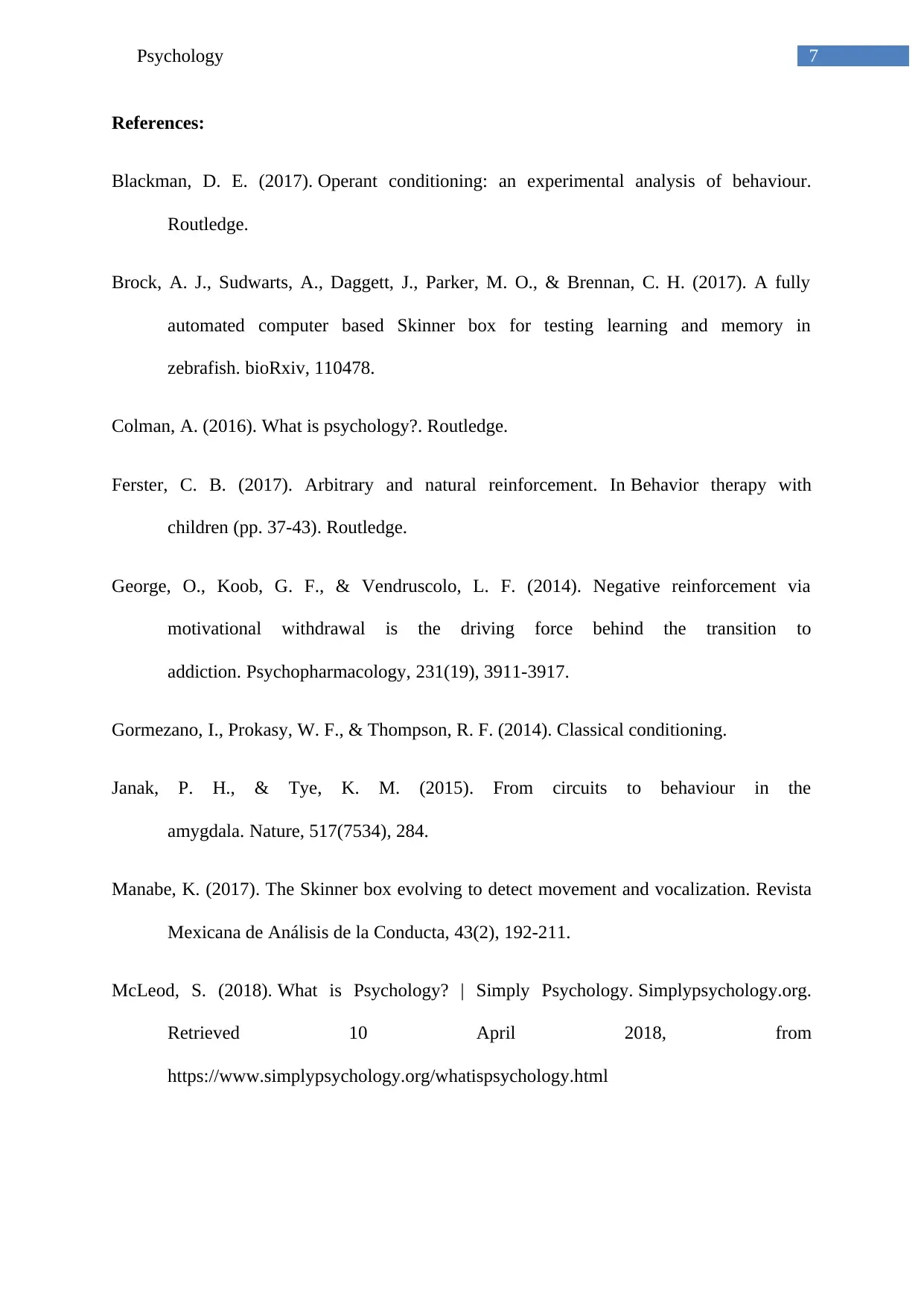
7Psychology
References:
Blackman, D. E. (2017). Operant conditioning: an experimental analysis of behaviour.
Routledge.
Brock, A. J., Sudwarts, A., Daggett, J., Parker, M. O., & Brennan, C. H. (2017). A fully
automated computer based Skinner box for testing learning and memory in
zebrafish. bioRxiv, 110478.
Colman, A. (2016). What is psychology?. Routledge.
Ferster, C. B. (2017). Arbitrary and natural reinforcement. In Behavior therapy with
children (pp. 37-43). Routledge.
George, O., Koob, G. F., & Vendruscolo, L. F. (2014). Negative reinforcement via
motivational withdrawal is the driving force behind the transition to
addiction. Psychopharmacology, 231(19), 3911-3917.
Gormezano, I., Prokasy, W. F., & Thompson, R. F. (2014). Classical conditioning.
Janak, P. H., & Tye, K. M. (2015). From circuits to behaviour in the
amygdala. Nature, 517(7534), 284.
Manabe, K. (2017). The Skinner box evolving to detect movement and vocalization. Revista
Mexicana de Análisis de la Conducta, 43(2), 192-211.
McLeod, S. (2018). What is Psychology? | Simply Psychology. Simplypsychology.org.
Retrieved 10 April 2018, from
https://www.simplypsychology.org/whatispsychology.html
References:
Blackman, D. E. (2017). Operant conditioning: an experimental analysis of behaviour.
Routledge.
Brock, A. J., Sudwarts, A., Daggett, J., Parker, M. O., & Brennan, C. H. (2017). A fully
automated computer based Skinner box for testing learning and memory in
zebrafish. bioRxiv, 110478.
Colman, A. (2016). What is psychology?. Routledge.
Ferster, C. B. (2017). Arbitrary and natural reinforcement. In Behavior therapy with
children (pp. 37-43). Routledge.
George, O., Koob, G. F., & Vendruscolo, L. F. (2014). Negative reinforcement via
motivational withdrawal is the driving force behind the transition to
addiction. Psychopharmacology, 231(19), 3911-3917.
Gormezano, I., Prokasy, W. F., & Thompson, R. F. (2014). Classical conditioning.
Janak, P. H., & Tye, K. M. (2015). From circuits to behaviour in the
amygdala. Nature, 517(7534), 284.
Manabe, K. (2017). The Skinner box evolving to detect movement and vocalization. Revista
Mexicana de Análisis de la Conducta, 43(2), 192-211.
McLeod, S. (2018). What is Psychology? | Simply Psychology. Simplypsychology.org.
Retrieved 10 April 2018, from
https://www.simplypsychology.org/whatispsychology.html
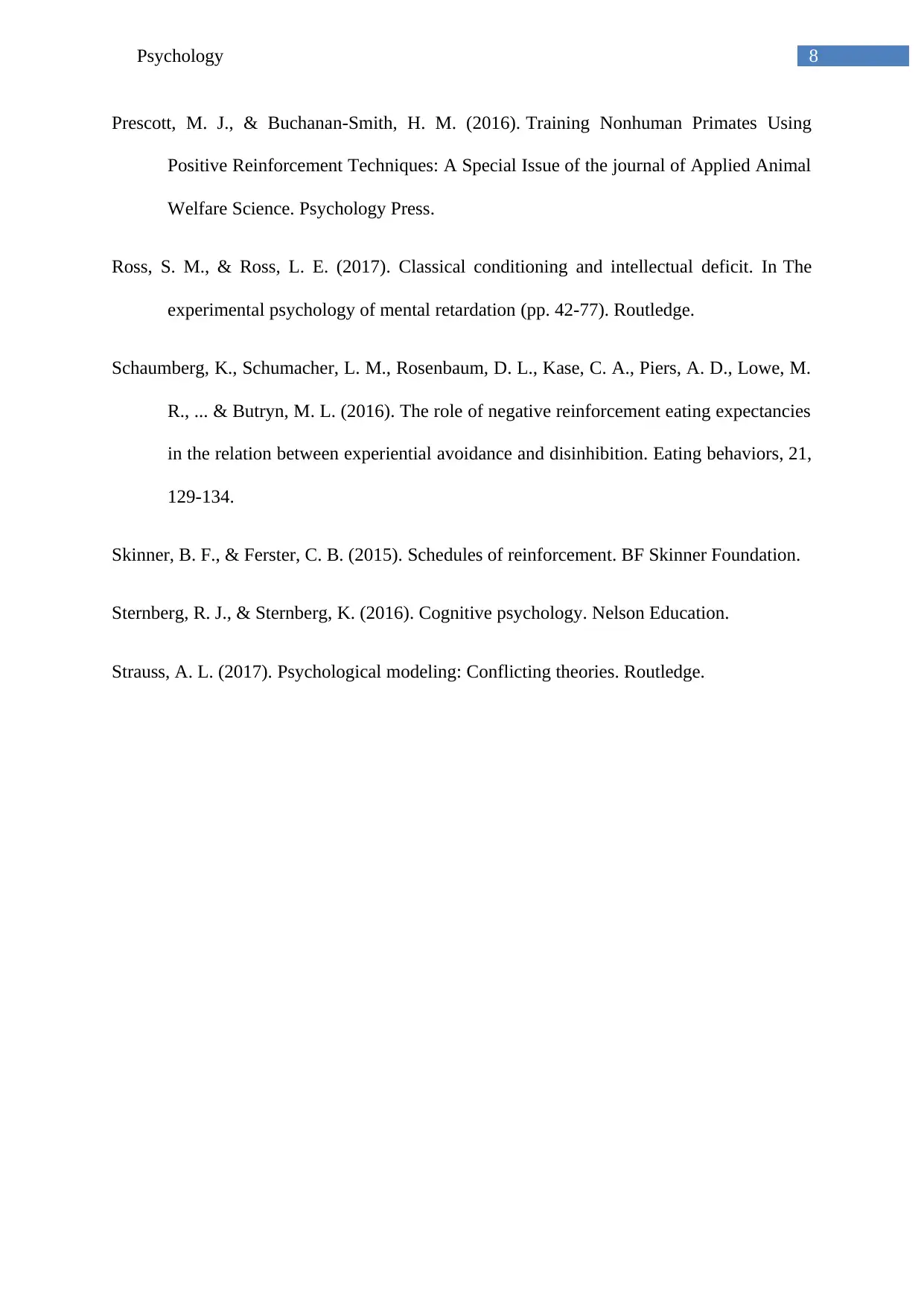
8Psychology
Prescott, M. J., & Buchanan-Smith, H. M. (2016). Training Nonhuman Primates Using
Positive Reinforcement Techniques: A Special Issue of the journal of Applied Animal
Welfare Science. Psychology Press.
Ross, S. M., & Ross, L. E. (2017). Classical conditioning and intellectual deficit. In The
experimental psychology of mental retardation (pp. 42-77). Routledge.
Schaumberg, K., Schumacher, L. M., Rosenbaum, D. L., Kase, C. A., Piers, A. D., Lowe, M.
R., ... & Butryn, M. L. (2016). The role of negative reinforcement eating expectancies
in the relation between experiential avoidance and disinhibition. Eating behaviors, 21,
129-134.
Skinner, B. F., & Ferster, C. B. (2015). Schedules of reinforcement. BF Skinner Foundation.
Sternberg, R. J., & Sternberg, K. (2016). Cognitive psychology. Nelson Education.
Strauss, A. L. (2017). Psychological modeling: Conflicting theories. Routledge.
Prescott, M. J., & Buchanan-Smith, H. M. (2016). Training Nonhuman Primates Using
Positive Reinforcement Techniques: A Special Issue of the journal of Applied Animal
Welfare Science. Psychology Press.
Ross, S. M., & Ross, L. E. (2017). Classical conditioning and intellectual deficit. In The
experimental psychology of mental retardation (pp. 42-77). Routledge.
Schaumberg, K., Schumacher, L. M., Rosenbaum, D. L., Kase, C. A., Piers, A. D., Lowe, M.
R., ... & Butryn, M. L. (2016). The role of negative reinforcement eating expectancies
in the relation between experiential avoidance and disinhibition. Eating behaviors, 21,
129-134.
Skinner, B. F., & Ferster, C. B. (2015). Schedules of reinforcement. BF Skinner Foundation.
Sternberg, R. J., & Sternberg, K. (2016). Cognitive psychology. Nelson Education.
Strauss, A. L. (2017). Psychological modeling: Conflicting theories. Routledge.
⊘ This is a preview!⊘
Do you want full access?
Subscribe today to unlock all pages.

Trusted by 1+ million students worldwide
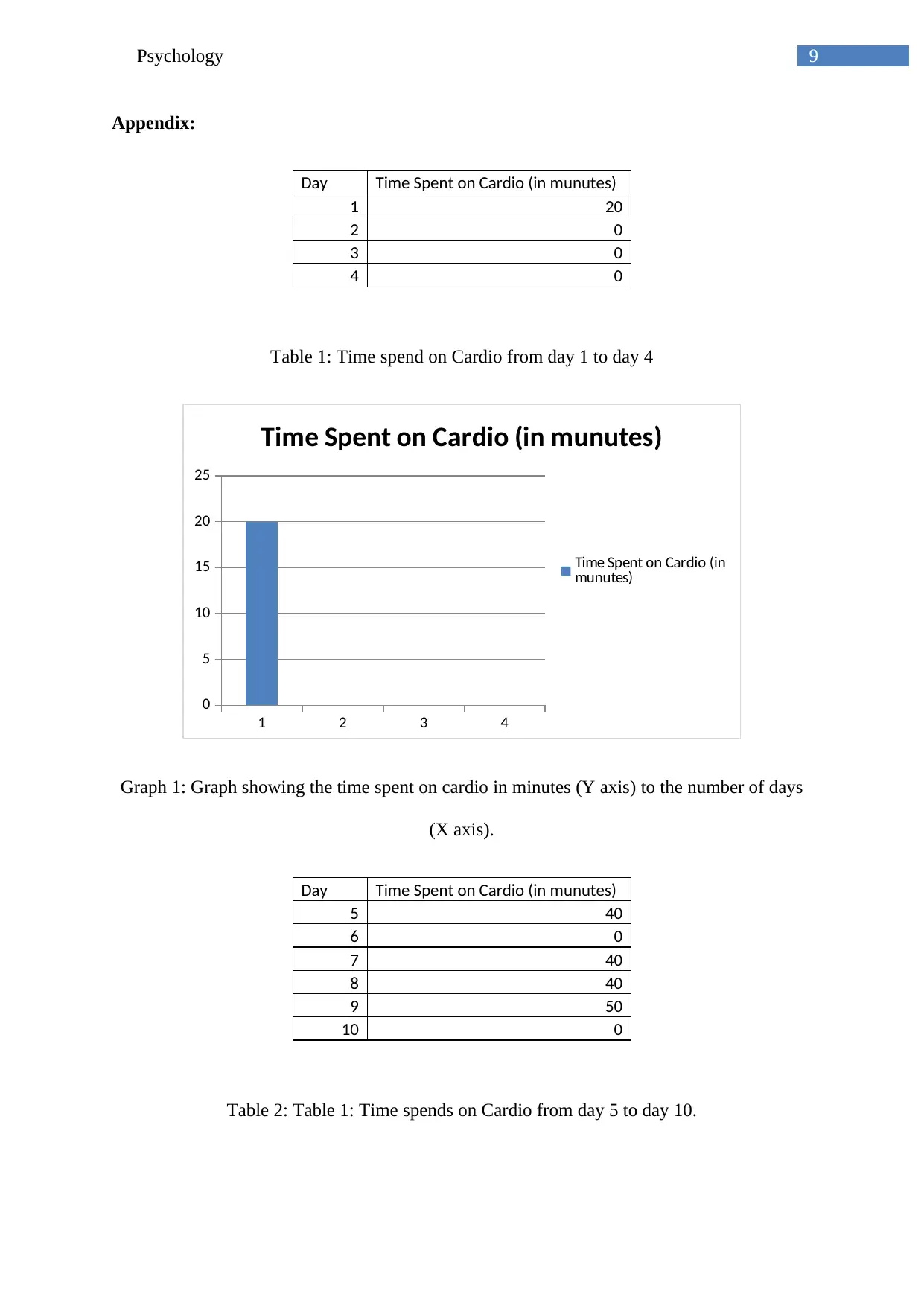
9Psychology
Appendix:
Day Time Spent on Cardio (in munutes)
1 20
2 0
3 0
4 0
Table 1: Time spend on Cardio from day 1 to day 4
1 2 3 4
0
5
10
15
20
25
Time Spent on Cardio (in munutes)
Time Spent on Cardio (in
munutes)
Graph 1: Graph showing the time spent on cardio in minutes (Y axis) to the number of days
(X axis).
Day Time Spent on Cardio (in munutes)
5 40
6 0
7 40
8 40
9 50
10 0
Table 2: Table 1: Time spends on Cardio from day 5 to day 10.
Appendix:
Day Time Spent on Cardio (in munutes)
1 20
2 0
3 0
4 0
Table 1: Time spend on Cardio from day 1 to day 4
1 2 3 4
0
5
10
15
20
25
Time Spent on Cardio (in munutes)
Time Spent on Cardio (in
munutes)
Graph 1: Graph showing the time spent on cardio in minutes (Y axis) to the number of days
(X axis).
Day Time Spent on Cardio (in munutes)
5 40
6 0
7 40
8 40
9 50
10 0
Table 2: Table 1: Time spends on Cardio from day 5 to day 10.
Paraphrase This Document
Need a fresh take? Get an instant paraphrase of this document with our AI Paraphraser
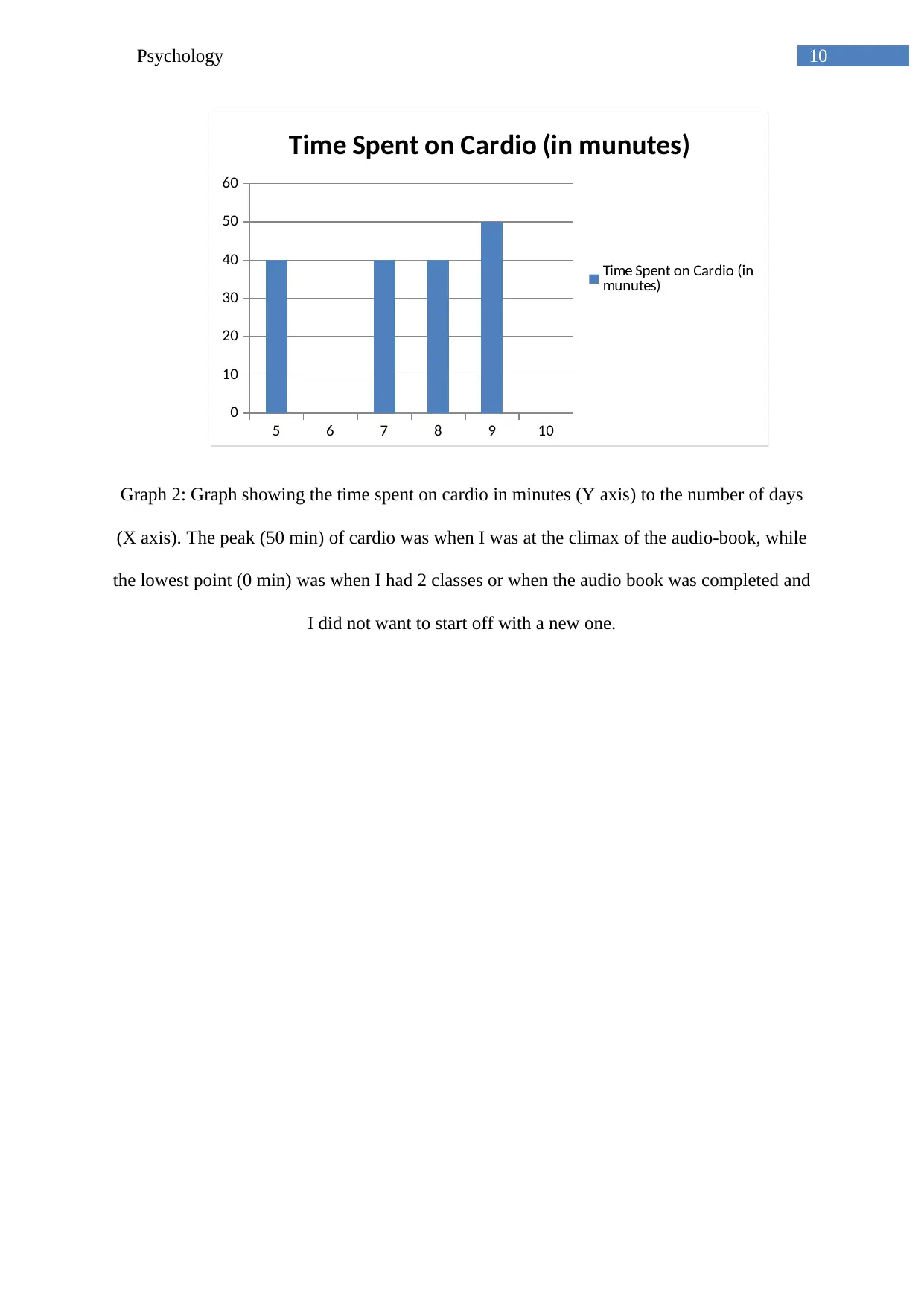
10Psychology
5 6 7 8 9 10
0
10
20
30
40
50
60
Time Spent on Cardio (in munutes)
Time Spent on Cardio (in
munutes)
Graph 2: Graph showing the time spent on cardio in minutes (Y axis) to the number of days
(X axis). The peak (50 min) of cardio was when I was at the climax of the audio-book, while
the lowest point (0 min) was when I had 2 classes or when the audio book was completed and
I did not want to start off with a new one.
5 6 7 8 9 10
0
10
20
30
40
50
60
Time Spent on Cardio (in munutes)
Time Spent on Cardio (in
munutes)
Graph 2: Graph showing the time spent on cardio in minutes (Y axis) to the number of days
(X axis). The peak (50 min) of cardio was when I was at the climax of the audio-book, while
the lowest point (0 min) was when I had 2 classes or when the audio book was completed and
I did not want to start off with a new one.

11Psychology
⊘ This is a preview!⊘
Do you want full access?
Subscribe today to unlock all pages.

Trusted by 1+ million students worldwide
1 out of 12
Related Documents
Your All-in-One AI-Powered Toolkit for Academic Success.
+13062052269
info@desklib.com
Available 24*7 on WhatsApp / Email
![[object Object]](/_next/static/media/star-bottom.7253800d.svg)
Unlock your academic potential
Copyright © 2020–2025 A2Z Services. All Rights Reserved. Developed and managed by ZUCOL.





